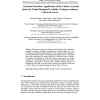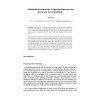149 search results - page 16 / 30 » Incorporating Cognitive Aspects in Digital Human Modeling |
HCI
2009
13 years 5 months ago
2009
Emotion is an important mental and physiological state, influencing cognition, perception, learning, communication, decision making, etc. It is considered as a definitive important...
HCI
2009
13 years 5 months ago
2009
Task time is a measure of productivity in an interface. Keystroke Level Modeling (KLM) can predict experienced user task time to within 10 to 30% of actual times. One of the bigges...
NIPS
2007
13 years 9 months ago
2007
We propose an active learning algorithm that learns a continuous valuation model from discrete preferences. The algorithm automatically decides what items are best presented to an...
IUI
2004
ACM
14 years 28 days ago
2004
ACM
While developing the Simple Gesturing User Interface (SGUI) API for incorporating simple gestures into personal digital assistant (PDA) user interfaces, we developed an object-bas...
TASLP
2011
13 years 2 months ago
2011
—This paper presents a novel student model intended to automate word-list-based reading assessments in a classroom setting, specifically for a student population that includes b...


